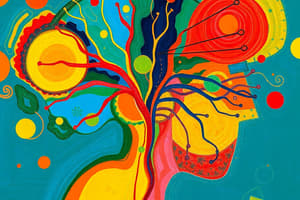Podcast
Questions and Answers
What is the main function of the Peripheral Nervous System (PNS)?
What is the main function of the Peripheral Nervous System (PNS)?
- Gathers information and controls higher functions like cognition and memory
- Acts based on the process and controls voluntary movements
- Provides an interface between the CNS and the environment (correct)
- Monitors the organs and controls involuntary actions
Which division of the Peripheral Nervous System (PNS) is responsible for 'Fight or flight' responses?
Which division of the Peripheral Nervous System (PNS) is responsible for 'Fight or flight' responses?
- Parasympathetic division
- Visceral Sensory division
- Sympathetic division (correct)
- Somatic Sensory division
What is the main function of ganglia in the nervous system?
What is the main function of ganglia in the nervous system?
- Acts as the main apparatus for receiving signals from other cells
- Contains granules with neurotransmitter
- Communicates by electrical signals or releasing chemicals
- Clusters cell bodies with similar functions together in the PNS (correct)
What is the main function of a neuron's axon terminal?
What is the main function of a neuron's axon terminal?
What is the main function of the Central Nervous System (CNS)?
What is the main function of the Central Nervous System (CNS)?
Which type of neuron has multiple origins?
Which type of neuron has multiple origins?
What is the function of microglia in the central nervous system?
What is the function of microglia in the central nervous system?
Which type of epithelial tissue is found in the gastrointestinal tract?
Which type of epithelial tissue is found in the gastrointestinal tract?
What is the major constituent of connective tissue's extracellular matrix (ECM)?
What is the major constituent of connective tissue's extracellular matrix (ECM)?
What do fibroblasts in connective tissue mainly synthesize and secrete?
What do fibroblasts in connective tissue mainly synthesize and secrete?
Flashcards are hidden until you start studying
Study Notes
Peripheral Nervous System (PNS)
- The main function is to connect the Central Nervous System (CNS) to limbs and organs, facilitating communication between the body and the brain.
Fight or Flight Response
- The sympathetic division of the PNS controls 'Fight or Flight' responses, preparing the body to react to stressful situations by increasing heart rate and redirecting blood flow.
Ganglia in the Nervous System
- Ganglia serve as relay points and processing centers for signals in the nervous system, housing the cell bodies of neurons and facilitating communication between different parts of the nervous system.
Neuron's Axon Terminal
- The axon terminal's primary function is to transmit signals to other neurons or target cells through the release of neurotransmitters, enabling communication across synapses.
Central Nervous System (CNS)
- The CNS's main function is to process and integrate information, coordinating voluntary and involuntary actions, and serving as the control center for the body.
Neuron Types
- Multipolar neurons have multiple origins, featuring multiple dendrites that allow them to process a large number of signals simultaneously.
Microglia Function
- Microglia act as the immune defense in the CNS, removing waste and pathogens through phagocytosis, and supporting overall brain health.
Epithelial Tissue in Gastrointestinal Tract
- Simple columnar epithelium is predominantly found in the gastrointestinal tract, playing vital roles in absorption and secretion.
Connective Tissue Extracellular Matrix
- Collagen is a major constituent of the extracellular matrix (ECM) in connective tissue, providing structural support and strength.
Fibroblasts in Connective Tissue
- Fibroblasts primarily synthesize and secrete collagen and elastin fibers, essential for maintaining the structure and function of connective tissues.
Studying That Suits You
Use AI to generate personalized quizzes and flashcards to suit your learning preferences.




